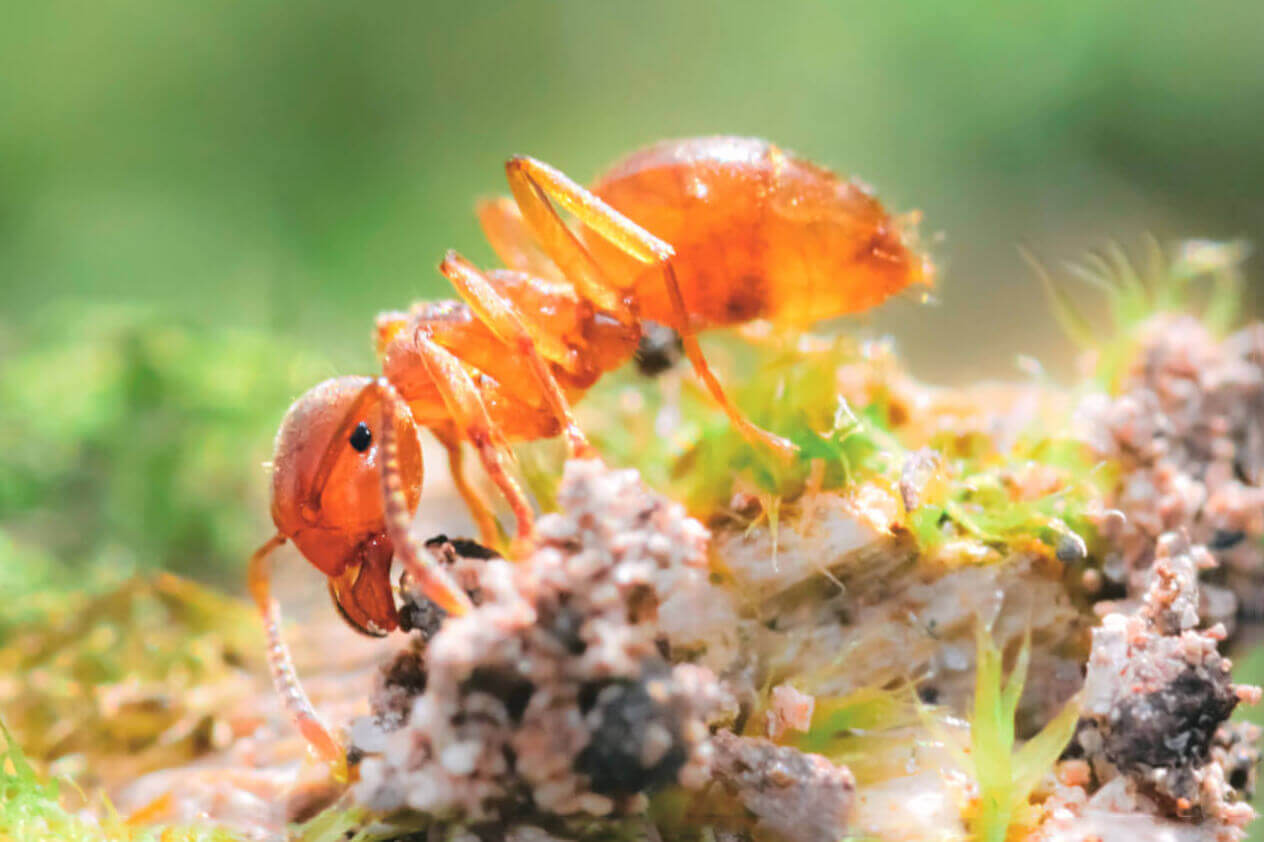Citronella Ant Facts & Information
Everything you need to know about citronella ants
What do citronella ants look like

Citronella ants get their name from the lemon verbena or citronella odor they emit when threatened. It is most noticeable when the ants are crushed. They are subterranean insects that feed on the honeydew (excretions) of aphids and mealybugs feeding on the roots of shrubs.
Both the larger and the smaller yellow ant are found throughout much of the continental United States. They are very common in the eastern United States and are frequently confused with termites when they swarm into the living areas of homes. In both species, the swarmers (winged ants) may vary in color from the more common light yellow to a dark reddish-yellow or light brown. The workers are typically yellow with less color variation than the swarmers.
Of the two species, the larger yellow ant (L. interjectus) is the most commonly encountered in Massachusetts, Connecticut, New York, Maine, Vermont, New Hampshire, and Rhode Island homes and businesses. The workers are 4 to 4.5 mm long and have 12-segmented antennae, with the scape (first antennal segment) just reaching the top of the head. They have a single node to the pedicel connecting the thorax and abdomen, with sparse, erect hairs on the head, thorax, and abdomen.
The swarmers are approximately twice the size of the workers and have dark, smoke-colored wings. Like the workers, they can also vary in color from a light yellow to light reddish-brown. Other than its size (workers are 3 to 4 mm), the smaller yellow ant looks similar to the larger yellow ant.Not the ant you have?
Both the larger and the smaller yellow ant are found throughout much of the continental United States. They are very common in the eastern United States and are frequently confused with termites when they swarm into the living areas of homes. In both species, the swarmers (winged ants) may vary in color from the more common light yellow to a dark reddish-yellow or light brown. The workers are typically yellow with less color variation than the swarmers.
Of the two species, the larger yellow ant (L. interjectus) is the most commonly encountered in Massachusetts, Connecticut, New York, Maine, Vermont, New Hampshire, and Rhode Island homes and businesses. The workers are 4 to 4.5 mm long and have 12-segmented antennae, with the scape (first antennal segment) just reaching the top of the head. They have a single node to the pedicel connecting the thorax and abdomen, with sparse, erect hairs on the head, thorax, and abdomen.
The swarmers are approximately twice the size of the workers and have dark, smoke-colored wings. Like the workers, they can also vary in color from a light yellow to light reddish-brown. Other than its size (workers are 3 to 4 mm), the smaller yellow ant looks similar to the larger yellow ant.Not the ant you have?
How Did I Get Citronella Ants
Citronella ants should be considered only as a nuisance pest species. Normally, they go unnoticed unless the swarmers enter through expansion cracks in slabs or around door openings. If you have those types of cracks and crevices, then any pest – not just citronella ants – can certainly get in. Although these intrusions may alarm homeowners, the ants will not reproduce within the home, nor will they attack stored goods or structures.
In some cases, swarms may occur repeatedly, and attempts should be made to locate the colony or colonies. Colonies typically have mounds of soil around the openings where excavated soil is deposited. These mounds can be treated by injecting an insecticide into the holes. Although numerous insecticides are labeled for ant control, many of these can and should only be used by licensed individuals.
In some cases, swarms may occur repeatedly, and attempts should be made to locate the colony or colonies. Colonies typically have mounds of soil around the openings where excavated soil is deposited. These mounds can be treated by injecting an insecticide into the holes. Although numerous insecticides are labeled for ant control, many of these can and should only be used by licensed individuals.

Little is known about the inner workings of these subterranean colonies. The ants are believed to tend aphids (much as dairy farmers would cows) and collect the honeydew they excrete. They are not known to forage for other food sources. Nest sites may include open woods, pastures and fallow fields, gardens, lawns, and next to house foundations. Also, some colonies are located beneath concrete slabs and large rocks, and in and beneath rotting logs.
Swarms may occur in and around homes any time of the year. The most common swarming occurs in mid- to late summer, but swarmers have been collected from homes during late autumn and early spring. These early and late season swarms are possibly an abnormality created by the warmer soils under and adjacent to heated structures.
Swarms may occur in and around homes any time of the year. The most common swarming occurs in mid- to late summer, but swarmers have been collected from homes during late autumn and early spring. These early and late season swarms are possibly an abnormality created by the warmer soils under and adjacent to heated structures.
Problems Caused by Citronella Ants
Repeated citronella ant swarms, which last for three or four days in June or July, are a nuisance. Fortunately, these ants don’t sting or cause damage and they don’t usually seek food inside the home. Because of their similar looks and behavior, they are easily mistaken for termites. That can be a problem since termites left unchecked can cause pricey damage to homes and businesses in our area. Bring in the ant exterminator that will not only properly identify the ant issue you have, but will provide the correct ant treatments.
How Do I Get Rid of Citronella Ants
Unfortunately, citronella ants do not respond to baits, so your best bet is to vacuum them up. However, if you continue to get swarms, your patience will probably be exhausted. One option is to caulk their entry points to the house to keep them out. Another is to hunt down the colony and consider exterminating it. At that point, your best bet is to bring in a professional exterminator to deal with the ants.
WHY OPC FOR CITRONELLA ANT CONTROL
We’re passionate about keeping citronella ants out of your home or business because we live and work here – it’s our neighborhood, too. We’ve been keeping homes and businesses in Kentucky, Ohio, Illinois, Indiana, and Wisconsin safe from pests since 1972. OPC Pest Services has the experience you can trust.
Expert pest control since 1972
Quality Pro certified company
Satisfaction guarantee
Say goodbye to citronella ants.
GET MY QUOTE
“Our technician is amazing! Ants are the bane of our existence and we didn’t have any this year! During his last visit he helped us remove some other pesky critters from our yard – hero! Always positive/happy! Thank you!”
Louisville, KY